The Exquisite Blend of Jim Beam and Sweet Tea
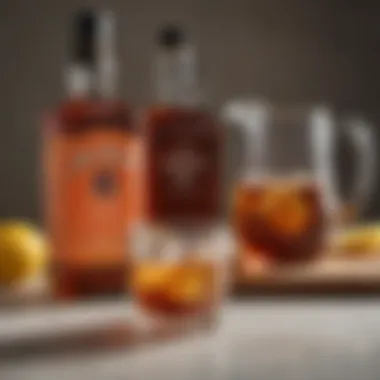
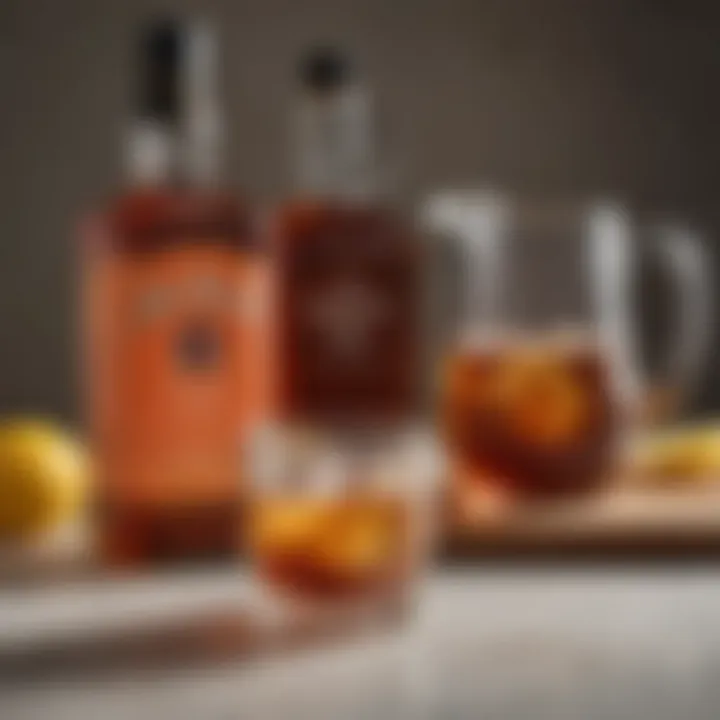
Intro
The combination of Jim Beam bourbon and sweet tea may seem unconventional at first, yet it represents a delightful fusion of flavors deeply rooted in Southern culture. This article uncovers how these two elements interact to create refreshingly unique beverages. It offers insights into their historical significance, flavor compatibility, and the cultural narrative that surrounds them. Moreover, it will provide readers with various cocktail recipes and practical tips for enjoying this pairing, ensuring that both casual drinkers and culinary enthusiasts will find something to captivate their interest.
Recipe Overview
Recipe Name and Description
One standout cocktail that showcases the harmony of Jim Beam and sweet tea is the Sweet Tea Bourbon Cocktail. This beverage pairs the smooth, caramel notes of Jim Beam with the rich sweetness of Southern-style tea, resulting in a delicious drink that is perfect for warm evenings on the porch. The combination not only highlights each component's qualities but also introduces an inviting warmth that can be a comforting experience.
Cuisine Type
This cocktail can be categorized under Southern cuisine, as it draws on traditional elements found in Southern hospitality and culinary practices. The ingredients and methods reflect a connection to the region's rich history of tea drinking and whiskey production.
Ingredients List
Detailed Ingredient Breakdown
- 2 oz Jim Beam Bourbon
- 4 oz sweet tea (preferably homemade)
- 1/2 oz fresh lemon juice
- Mint leaves for garnish
- Optional: A splash of peach schnapps for extra sweetness
Substitutions for Dietary Needs
Should one prefer a non-alcoholic option, using a non-alcoholic bourbon alternative can keep the flavor profile similar. For those looking to reduce sugar, using unsweetened iced tea or a sugar substitute can work as versatile replacements, while still capturing the essence of the drink.
"Harmonizing distinct flavors can lead to innovative culinary experiences."
Unlocking the full potential of Jim Beam and sweet tea goes beyond simply mixing a few ingredients. It is about appreciating the cultural significance, historical context, and the exquisite balance of flavors. As this article unfolds, it will delve deeper into the intricacies of this delightful pairing, offering readers a comprehensive understanding and appreciation of its unique stature in modern mixology.
Prelude to Jim Beam
Jim Beam is a name synonymous with quality bourbon whiskey, embodying not just a brand, but a significant portion of American distilling history. This article aims to illuminate the different facets of Jim Beam, setting a foundation for understanding its role when paired with sweet tea. As the reader explores this piece, it becomes clear that the importance of Jim Beam extends beyond its flavor; it delves into cultural, historical, and production aspects that enhance its appeal.
Historical Background
Jim Beam's origins trace back to 1795, making it one of the oldest distilleries in America. The founder, Jacob Beam, produced a whiskey that quickly gained local popularity. Over the decades, the Beam family has passed down mastery in distilling bourbon. The brand truly gained prominence in the 1930s when it adopted the name "Jim Beam." Each bottle encapsulates over two centuries of craftsmanship and technology development, played a crucial role in defining the bourbon industry.
This historical trajectory is not just a backdrop; it shapes every sip of Jim Beam whiskey. Knowing its past adds depth to the experience of consuming this bourbon and later combining it with sweet tea. The intertwining of Jim Beam’s history with Southern traditions provides an important context for understanding the ingredients and flavors involved in this unique combination.
Production and Craftsmanship
Jim Beam’s production process reflects a dedication to quality and traditional craftsmanship. Sourced from maize, the mash bill consists of at least 51% corn, blended with rye, barley, and other grains. The fermentation process, which is essential to developing flavor, utilizes pure limestone water from the region, known for its mineral composition that benefits whiskey quality.
After fermentation, distillation takes place in a column still, where precise temperature control is critical. The resulting spirit is aged in new charred American oak barrels, which impart essential flavors, such as vanilla and caramel. Aging can last up to four years or more, enhancing complexity.
This craftsmanship and attention to detail ensure that Jim Beam stands out among bourbons. These aspects lend an authenticity that not only appeals to bourbon lovers but also provides a solid base for experimenting with diverse culinary applications, such as the blend with sweet tea.
Flavor Profile and Characteristics
The flavor profile of Jim Beam is notably well-balanced. Upon tasting, one often notes hints of vanilla, caramel, and oak. Additional undertones may include subtle spices or fruit notes, making it a complex experience for the palate. The finish is typically smooth, yet rich in warmth, lasting well beyond the initial sip.
These characteristics are crucial when pairing with sweet tea. The sweetness and herbal qualities of tea balance with the bourbon's flavors. Recognizing and understanding these flavor dynamics elevates not only the appreciation of Jim Beam but also enriches the overall experience of combining it with sweet tea.
“Jim Beam is more than just a bourbon; it represents a slice of American tradition and craftsmanship.”
In summary, the introduction to Jim Beam lays the groundwork for its appreciation, particularly in combination with sweet tea. Understanding its history, production methods, and flavor profile enhances the exploration of this unique pairing.
Understanding Sweet Tea
Sweet tea is not just a beverage; it represents a cultural ethos deeply woven into the fabric of Southern life. This article emphasizes the importance of understanding sweet tea, particularly as we explore its harmony with Jim Beam.
Sweet tea plays a significant role in Southern hospitality. It often serves as a welcoming drink in homes across the region. The act of brewing and serving sweet tea is an expression of warmth and generosity. Many families have their unique recipes passed down through generations. This custom connects people to their heritage, making the beverage more than just a drink.
When combined with Jim Beam, sweet tea transforms into something compelling, enhancing both the whiskey's oak and caramel notes and the tea's natural sweetness. This relationship encourages enthusiasts to blend traditions and elements of culinary creativity.
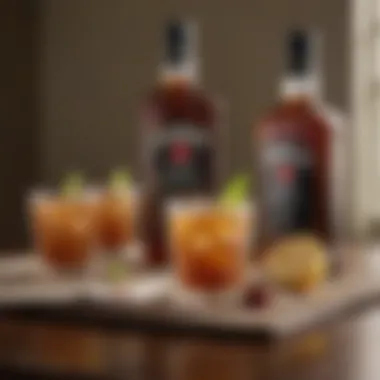
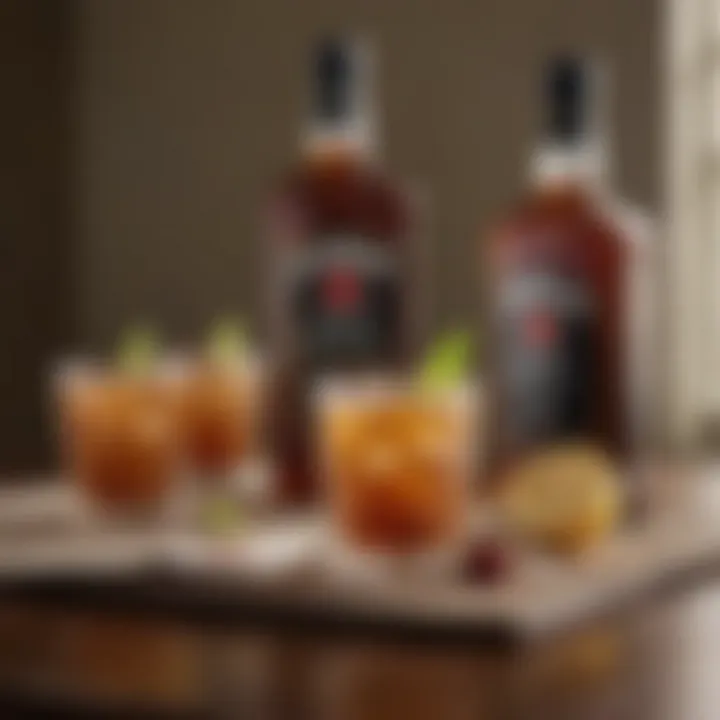
Cultural Significance in the South
In the Southern United States, sweet tea is more than a refreshing drink; it embodies a lifestyle. It is commonly served at gatherings, parties, and family meals. The method of brewing varies by family, but the essence of sweet tea remains consistent: simple ingredients to create something special.
Many communities celebrate it during gatherings, with people swapping stories while sipping sweet tea on porches. It signifies camaraderie and comfort.
Some historical accounts even link sweet tea to Civil War soldiers who mixed sugar with tea leaves, leading to its enduring popularity. Such ties underscore how beverages evolve into iconic symbols of culture and community.
Popular Recipes and Variations
There exists a rich variety of recipes for sweet tea across the South. Some common variations include:
- Lemon Sweet Tea: A zesty twist achieved by adding fresh lemon juice.
- Mint Sweet Tea: Infusing mint leaves during the brewing process for a refreshing taste.
- Spiked Sweet Tea: Adding vodka or, notably, Jim Beam for a unique twist.
Each recipe highlights how versatile sweet tea can be, adapting to personal tastes and occasions. Such innovations make sweet tea a perfect companion to bourbon, enhancing the overall tasting experience.
Health Considerations
While sweet tea offers comforting flavors, it is beneficial to consider health aspects. Traditional recipes often contain significant sugar levels, which can raise concerns about excessive calorie intake and sugary diets.
As people become more health-conscious, many seek alternatives for sweetening their tea. Popular options include:
- Stevia: A natural zero-calorie sweetener.
- Honey: A more natural sweetener, offering various health benefits.
- Agave Nectar: A sweeter option with a lower glycemic index than sugar.
Balancing sweetness when mixing with Jim Beam is essential. A well-crafted cocktail can offer indulgence without overwhelming the palate with sugar. Pay attention to sweetness levels to retain the authentic flavor profiles of both the sweet tea and the bourbon.
The Intersection of Jim Beam and Sweet Tea
The convergence of Jim Beam with sweet tea creates an intriguing exploration of flavors and cultural significance. This pairing is not merely a choice of beverage; it reflects a nuanced appreciation of Southern culinary traditions. By examining this intersection, one can appreciate how Jim Beam, with its rich heritage, complements the refreshing qualities of sweet tea. The combination invites culinary enthusiasts to experience a harmonious melding that enhances both components.
Historical Context of the Pairing
The roots of this pairing can be traced back through the drinking customs of the American South. Sweet tea, a staple in Southern households, has been enjoyed for generations. Its origin dates from the 19th century when iced tea became popular, especially during the hot summer months. Jim Beam, established in 1795, represents a tradition rooted in whiskey production. The combination of these two iconic elements can be seen as a reflection of regional identity.
Historically, this beverage duo gained popularity during gatherings and social events. Family reunions, barbecues, and celebrations often featured sweet tea, and adding bourbon provided a sophisticated twist. This blending not only elevated the drink's enjoyment but also incorporated the bourbon's rich history into Southern culture, making it even more noteworthy.
Flavor Combination and Impact
The interplay between the sweet warmth of Jim Beam and the crisp, sugary notes of sweet tea creates a balanced flavor profile. Jim Beam, known for its smooth finish and hints of vanilla and caramel, contrasts yet complements the revitalizing taste of sweet tea. Even a simple mix reveals a magnitude of textures and sensations, altering the drinker's palate.
When served together, this pairing sparks an exciting experience. The sweetness in tea cuts the alcohol's bite and highlights its depth. This interplay proves particularly appealing during social activities, where individuals seek both refreshement and relaxation. Overall, the flavor impact invites drinkers to savor the nuances of both ingredients.
Social and Cultural Implications
The marriage of Jim Beam and sweet tea extends beyond the glass. It reflects the Southern way of life, where hospitality and warmth are paramount. Southern gatherings often feature this duo, creating a sense of community among participants. The drink symbolizes celebration and togetherness, serving as a bridge between generations.
Socially, this combination has evolved to be more than just a beverage; it can typify regional pride. As the popularity of craft cocktails grows, incorporating classic elements like sweet tea speaks to a desire for authenticity in social experiences. Event organizers and bartenders alike are embracing this fusion, presenting it as a natural option on drink menus, appealing to a diverse audience.
Classic Cocktails Featuring Jim Beam and Sweet Tea
The combination of Jim Beam and sweet tea creates a unique culinary experience. These classic cocktails highlight the rich profile of bourbon alongside the refreshing character of sweet tea. Crafting cocktails that incorporate these two elements offers numerous benefits. They appeal to a wide variety of taste preferences, can be modified to suit different occasions, and provide a satisfying sensory experience. Furthermore, these drinks encapsulate the cultural history of Southern hospitality.
Jim Beam Sweet Tea Cocktail
The Jim Beam Sweet Tea Cocktail is a straightforward yet satisfying drink. This cocktail blends Jim Beam bourbon with sweet tea, adding a simple twist to two well-loved ingredients. Its preparation is remarkably easy, making it an excellent choice for both novice and experienced mixologists.
Ingredients:
- 2 oz Jim Beam bourbon
- 4 oz sweet tea
- Fresh lemon slice
- Ice
Instructions:
- Fill a glass with ice.
- Pour the Jim Beam bourbon over the ice.
- Add the sweet tea, mixing gently.
- Garnish with a fresh slice of lemon.
This cocktail ensures a harmonious balance of flavors, where the sweetness of the tea and the richness of the bourbon complement each other perfectly.
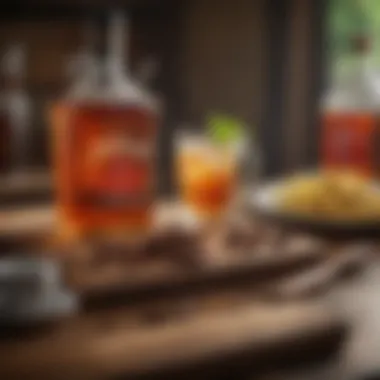

Sweet Tea Bourbon Smash
The Sweet Tea Bourbon Smash introduces a deeper complexity with the addition of mint and fresh lemon. This cocktail elevates the classic Jim Beam and sweet tea mix into a refreshing beverage ideal for warm afternoons. The combination of fresh herbs, citrus, and whiskey creates a lively experience.
Ingredients:
- 2 oz Jim Beam bourbon
- 3 oz sweet tea
- 1 oz fresh lemon juice
- Mint leaves
- Ice
Instructions:
- In a shaker, muddle a few mint leaves with lemon juice.
- Fill the shaker with ice and add the bourbon and sweet tea.
- Shake well.
- Strain into a glass filled with ice and garnish with a sprig of mint.
This cocktail showcases the versatility of Jim Beam bourbon. Its refreshing taste is sure to appeal to anyone seeking a light drink with a touch of sophistication.
Southern Sweet Tea Highball
The Southern Sweet Tea Highball takes a classic highball drink and gives it a Southern twist. This cocktail is ideal for gatherings, as it can be made in larger quantities to serve a group. The combination of soda and bourbon finishes with a refreshing sweetness where the sweet tea plays a crucial role.
Ingredients:
- 2 oz Jim Beam bourbon
- 4 oz sweet tea
- Club soda to top up
- Lemon wedge for garnish
Instructions:
- In a tall glass filled with ice, add the Jim Beam bourbon and sweet tea.
- Top off with club soda.
- Stir gently and garnish with a lemon wedge.
This drink captures the essence of Southern summer gatherings and casual get-togethers, making it perfect for almost any occasion.
Preparing the Perfect Jim Beam and Sweet Tea Mix
The combination of Jim Beam and sweet tea offers both tradition and innovation. Understanding how to prepare this mix properly is crucial for achieving the right balance in flavors and overall experience. The selection of appropriate ingredients, techniques, and serving suggestions can elevate a simple drink into something remarkable. This section focuses on the key elements that can help anyone create the perfect blend.
Choosing the Right Ingredients
The first step in preparing a great Jim Beam and sweet tea mix is selecting high-quality ingredients. Here are important components to consider:
- Jim Beam Bourbon: Choose a good quality Jim Beam product. Options like Jim Beam Original or Jim Beam Honey add distinct flavors that enhance the mix.
- Sweet Tea: Using freshly brewed sweet tea is essential. Store-bought versions may contain preservatives. Homemade sweet tea, made with black tea and a suitable amount of sugar, will lead to a fresher taste.
- Sugar Levels: The type and amount of sugar will influence sweetness. Cane sugar can create a different mouthfeel compared to honey or agave syrup.
The quality of ingredients not only impacts the taste but also reflects on the overall enjoyment of the drink.
Brewing Techniques for Optimal Flavor
Brewing sweet tea properly is as crucial as choosing the right bourbon. Here are techniques that help achieve the best flavor:
- Tea Selection: Black tea is the classic choice for sweet tea. Choose high-quality loose leaf or bagged varieties for optimal flavor extraction.
- Brewing Method: Follow these steps to brew the tea:
- Cooling Process: Allow the sweet tea to cool completely before mixing it with Jim Beam. This step is vital to ensure that ice does not dilute the drink immediately upon serving.
- Boil water and steep the tea for about 3-5 minutes, depending on desired strength.
- Remove tea bags or strain leaves to prevent bitterness from over-extraction.
- Add sugar while the tea is still hot to properly dissolve it.
Using proper brewing techniques ensures that the taste and aroma of the sweet tea complements Jim Beam beautifully.
Serving Suggestions
Proper serving can enhance the drinking experience significantly. Here are some inviting ways to serve Jim Beam and sweet tea:
- Glassware: Use tall, chilled glasses to showcase the drink. Highball or mason jars can add a rustic charm.
- Ice Choices: Large ice cubes or spheres are preferable as they melt slower. This reduces dilution during enjoyment.
- Garnishes: Consider garnishing with fresh mint leaves or lemon slices. These add visual appeal and subtler flavors that can enhance the mix.
- Proportions: A common ratio is 1 part Jim Beam to 2 parts sweet tea, but this can be adjusted based on personal preference.
By carefully choosing each element, from ingredients to serving practices, one can prepare a delightful Jim Beam and sweet tea mix that stands out. The process is not just about combining two items; it’s about creating a balanced and harmonious drink.
Variations on Sweetness in Sweet Tea
When discussing sweet tea, one cannot overlook the variations in sweetness levels. This topic is essential in understanding how these adjustments can affect the flavor profile and overall experience with Jim Beam. Through such variations, individuals can cater to personal preferences as well as create unique drinking experiences. It allows room for creativity and exploration, which is significant when mixing beverages like Jim Beam and sweet tea.
Adjusting Sweetness Levels
Adjusting sweetness levels in sweet tea is a fundamental practice that affects its taste dramatically. Different people have varying preferences regarding sweetness. Some enjoy a robust and sugary taste, while others may prefer a more subtle hint of sweetness.
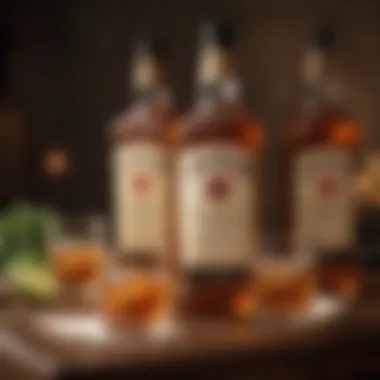
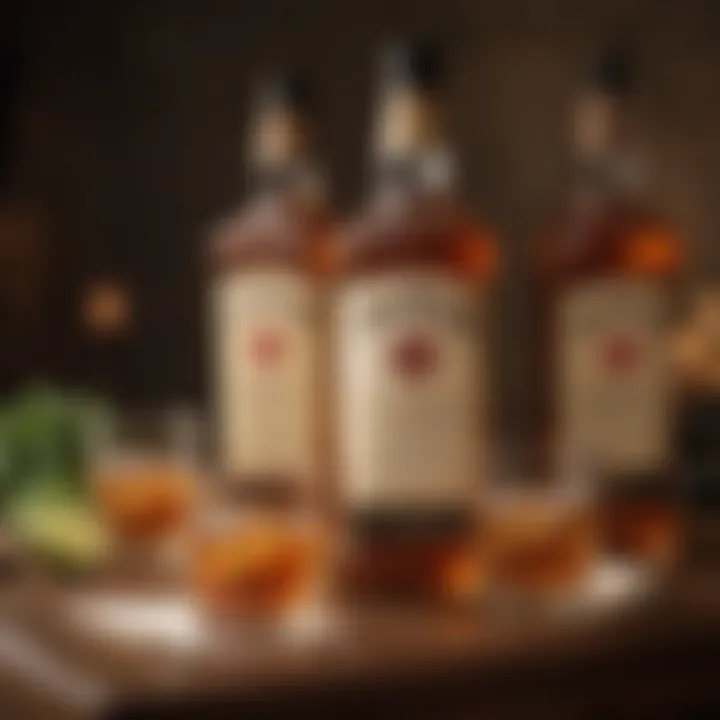
Experiments with different levels of sugar can lead to delightful discoveries. Here are a few ways to adjust sweetness levels in sweet tea:
- Traditional Sugar: Using granulated sugar is classic, but it dissolves best in hot water. Adding it while brewing tea ensures a uniform sweetness.
- Simple Syrup: This syrup is created by dissolving equal parts sugar and water. It mixes easily and allows for precise control over sweetness.
- Honey or Agave Syrup: These alternatives offer a unique flavor while sweetening the tea. They can significantly alter the taste profile of the resulting concoction.
Use of Alternative Sweeteners
For those who are health-conscious or have dietary restrictions, alternative sweeteners can provide satisfactory options. They allow enjoyment of sweet tea without traditional sugars.
- Stevia: A natural, zero-calorie sweetener derived from the stevia plant, it is much sweeter than sugar. A small amount can provide enough sweetness for a cup of tea.
- Monk Fruit: This sweetener is also calorie-free and derived from a fruit. It does not affect blood sugar levels and is gaining popularity as a natural sweetener.
- Artificial Sweeteners: Products like aspartame or sucralose can also be considered. They provide sweetness without calories but come with varying opinions on health impacts.
Balancing Alcohol Content
While mixing Jim Beam with sweet tea, balancing the alcohol content is critical. The sweetness can mask the strength of the bourbon, but one should be cautious. Balancing ensures that the drink remains enjoyable without being overly sweet or too potent.
When crafting a drink, consider the following:
- Start with Small Measurements: Begin with a modest amount of Jim Beam. You can always add more bourbon if needed.
- Taste as You Go: Continuously taste the mixture to achieve the desired balance of sweetness and alcohol.
- Experiment with Ratios: Find the perfect ratio of Jim Beam to sweet tea that suits your palate.
Culinary Applications Beyond Drinks
The combination of Jim Beam and sweet tea extends far beyond the realm of beverages. This pairing reveals an entire universe of culinary creativity that transcends mere mixing. Understanding the various applications of this fusion encourages both chefs and home cooks to explore unique flavor profiles and elevate their dishes. The melding of Jim Beam's rich, caramel notes with the sweetness of tea opens doors for new culinary experiences.
The benefits of incorporating this combination into cooking are manifold. First, marinades and glazes can transform simple meats into gourmet meals. The alcohol content in bourbon acts as a tenderizer, enhancing the texture of proteins. Additionally, the sweetness from tea adds a touch of complexity that balances savory flavors beautifully.
Aside from savory applications, Jim Beam and sweet tea can enhance desserts, intertwining sweetness with depth. The interplay of these flavors can give rise to unique desserts, providing an explosion of taste that surprises the palate. Sweet tea can be a base for sorbets or used in infusions, while Jim Beam can lend a bourbon caramel sauce, a sure way to elevate any dessert.
Lastly, in the realm of innovative drinks, this combination can inspire creative cocktail innovations. Bartenders can experiment with classic recipes or develop new ones that highlight the distinct qualities of each ingredient. This exploration can lead to refreshing twists on well-known drinks.
Overall, integrating Jim Beam and sweet tea into culinary applications enriches the dining experience. It invites adventurous cooks to think outside the box and create dishes that not only taste exceptional but also tell a story.
Marinades and Glazes
Marinades and glazes are a perfect starting point for utilizing Jim Beam and sweet tea. When used as a marinade, Jim Beam enhances the meat with a depth that is both smoky and sweet. The alcohol not only adds flavor but also tenderizes the meat, making it more succulent. A simple marinade could combine Jim Beam, sweet tea, soy sauce, garlic, and ginger. This blend works beautifully with chicken or pork, infusing the proteins with unique flavors.
When it comes to glazes, the same principles apply. A reduced mixture of sweet tea and bourbon can create a sticky, sweet glaze that caramelizes beautifully on the grill or in the oven. This glaze can elevate grilled vegetables, meats, and even fish. The key is to balance the sweetness of the tea with the rich, bold flavor of the bourbon. The result is a glaze that brings everything together, creating depth and sophistication in your dish.
Desserts Featuring the Pairing
Desserts featuring Jim Beam and sweet tea can provide an exciting twist to traditional recipes. For instance, a sweet tea-infused panna cotta can serve as a creamy base, while a Jim Beam bourbon caramel sauce drizzled on top adds complexity. The result is a dessert that balances delicate flavors with a rich finish, appealing to those who enjoy both smooth and robust tastes.
Another delicious application is sweet tea ice cream, spiced with Jim Beam for an adult treat. The creaminess of the ice cream combined with the sharpness of bourbon enhances the sweet tea flavor, making it a perfect refreshment during warm months.
Creative Cocktail Innovations
The world of cocktails offers another canvas for experimentation with Jim Beam and sweet tea. Traditional Southern drinks like the sweet tea highball can be elevated by adding flavored bitters or fresh herbs. For example, a sprig of mint or a squeeze of lemon can bring brightness and freshness to the drink.
Moreover, consider creating a cocktail that marries sweet tea with other spirits. A Jim Beam sweet tea fusion could blend sweet tea, bourbon, and fresh fruit juices, crafting a refreshing punch that can be enjoyed at summer gatherings.
Innovative bartenders might also play with the temperature, offering hot cocktails that incorporate tea and bourbon, perhaps using spices like cinnamon or even chili for an interesting twist.
Finale
The conclusion of this article serves as a reflection on the rich tapestry interwoven by Jim Beam and sweet tea. This pairing not only showcases a harmonious blend of flavors, but it embodies cultural significance that stretches across the Southern landscape. The fusion of these two elements speaks volumes about evolving culinary trends and the desire for innovative combinations that respect tradition while inspiring creativity.
Reflections on Culinary Fusion
Culinary fusion is more than just mixing ingredients. It is about creating a dialogue between different cultural practices and flavors. In the case of Jim Beam and sweet tea, we see a synthesis that captures the essence of the South. Choosing Jim Beam, known for its robust flavor profile, alongside sweet tea, which offers a refreshing sweetness, is a thoughtful amalgamation of taste and tradition. This pairing exemplifies how beloved regional specialties can be transformed into new experiences.
Moreover, this fusion presents an opportunity for individuals to rethink classic recipes. Many chefs and home cooks have taken this pairing and turned it into their own variations, often leading to novel cocktail creations and culinary explorations. The adaptability of Jim Beam and sweet tea encourages experimentation, allowing for diverse interpretations that still pay homage to their roots.
The Ongoing Popularity of Jim Beam and Sweet Tea
The enduring popularity of Jim Beam and sweet tea in the culinary landscape cannot be overlooked. With many individuals seeking comfort in familiar flavors, this combination provides a sense of nostalgia while also bringing innovation. Social gatherings across Southern states often feature this pairing, highlighting its role in bringing people together.
Additionally, the cocktail scene has embraced this duo, with bartenders continually crafting new drinks that elevate its status. From backyard barbecues to sophisticated bars, Jim Beam and sweet tea cocktails cater to varied tastes and occasions.
In summary, both elements hold a prominent place in contemporary culinary practices. The blend of Jim Beam and sweet tea captures the imagination of food lovers. Their combined history, flavor profiles, and cultural relevance ensures they will remain a celebrated pairing for years to come.
"The marriage of Jim Beam and sweet tea exemplifies how culinary traditions can inspire lasting favorites in modern gastronomy."
As we reflect on this intriguing pairing, it becomes clear that exploring the harmony between Jim Beam and sweet tea is not just about taste. It is about community, history, and the joy of shared experiences.















